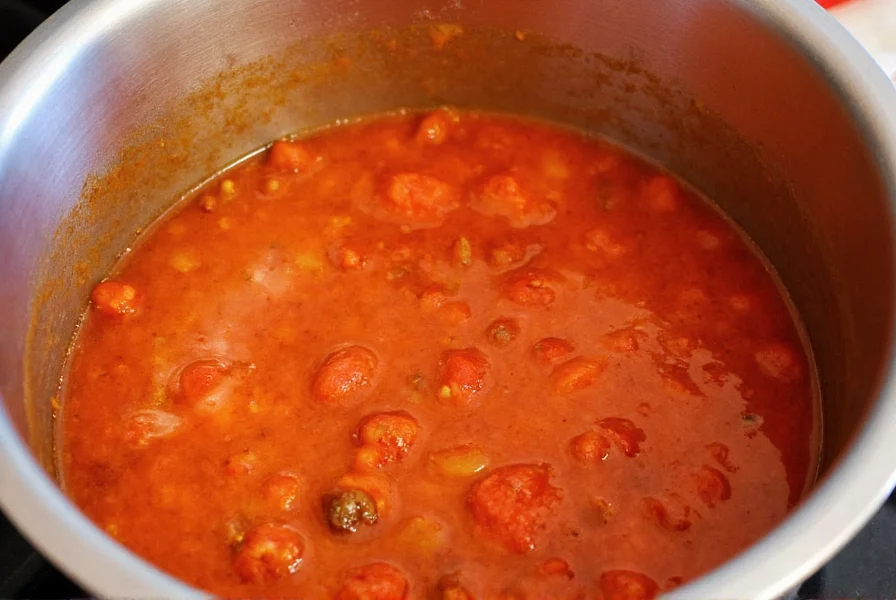Many home cooks search for a Heinz chili sauce recipe believing the iconic condiment company offers this specific product. This common misconception stems from confusion between ketchup, chili sauce, and other tomato-based condiments. Understanding the distinction between these products is essential before attempting to recreate that familiar Heinz flavor profile at home.
Understanding Heinz's Condiment Lineup
Heinz, established in 1869, has become synonymous with tomato ketchup, but their product range includes several other condiments. The company produces:
| Heinz Product | Primary Ingredients | Distinctive Features |
|---|---|---|
| Tomato Ketchup | Tomato concentrate, vinegar, sugar, salt, spices | Smoother texture, sweeter profile, thinner consistency |
| Steak Sauce | Vinegar, tomatoes, molasses, raisins, spices | Complex flavor, fruitier notes, darker color |
| Vinegar-Based Hot Sauce | Vinegar, chili peppers, salt, garlic | Sharp heat, thinner consistency |
Notably absent from this lineup is a dedicated chili sauce product. The confusion often arises because some grocery stores mislabel generic chili sauce products with "Heinz" branding, or consumers mistakenly associate the Heinz name with all tomato-based condiments.
What Is Chili Sauce Anyway?
Chili sauce differs from ketchup in several key ways. While both are tomato-based, traditional chili sauce contains:
- Whole or chopped chili peppers (not just powder)
- More vinegar for tanginess
- Distinct spice blend including cumin and garlic
- Less sugar than ketchup
- Often includes additional vegetables like onions
Commercial chili sauce typically has a chunkier texture and more pronounced heat than ketchup. It's commonly used as a topping for hot dogs, in meatloaf, or as a base for other sauces.
Authentic Homemade Chili Sauce Recipe
While there's no official Heinz chili sauce recipe from scratch, this homemade version captures the balanced tangy-sweet profile associated with quality commercial products. This recipe yields approximately 2 cups and takes 45 minutes to prepare.

Ingredients
- 2 (28-ounce) cans whole peeled tomatoes
- 1 large yellow onion, finely diced
- 3 cloves garlic, minced
- 1 medium green bell pepper, finely diced
- 2 jalapeño peppers, seeds removed, finely diced
- 1 cup apple cider vinegar
- 1/2 cup brown sugar
- 2 tablespoons chili powder
- 1 tablespoon ground cumin
- 1 teaspoon smoked paprika
- 1 teaspoon salt
- 1/2 teaspoon black pepper
- 1/4 teaspoon cayenne pepper (optional for extra heat)
Step-by-Step Instructions
- Combine all ingredients in a large, heavy-bottomed pot
- Bring to a gentle boil over medium-high heat, then reduce to a simmer
- Cover and simmer for 30 minutes, stirring occasionally
- Remove lid and continue simmering for another 10-15 minutes until thickened
- For smoother texture, use an immersion blender to partially puree (leave some texture)
- Cool slightly before transferring to sterilized jars
- Store in refrigerator for up to 2 weeks or process for canning
Customizing Your Homemade Chili Sauce
One advantage of making your own easy chili sauce recipe from scratch is the ability to customize it to your taste preferences:
- Sweeter version: Increase brown sugar to 3/4 cup for a profile closer to commercial ketchup-based products
- Smokier flavor: Add 1-2 teaspoons liquid smoke or an additional 1/2 teaspoon smoked paprika
- Milder version: Omit jalapeños and cayenne, using only bell peppers for sweetness
- Spicier kick: Include pepper seeds or add 1 habanero pepper
- Fruit-infused: Add 1/2 cup diced pineapple or mango for tropical notes
Storage and Usage Tips
Proper storage ensures your homemade chili sauce maintains quality and flavor:
- Refrigerate in airtight containers for up to 2 weeks
- Freeze in ice cube trays then transfer to freezer bags for up to 6 months
- Process in a water bath canner for shelf-stable storage up to 1 year
- Always use clean utensils when serving to prevent contamination
This versatile sauce works beautifully as:
- A topping for hot dogs, burgers, and sandwiches
- A glaze for meats (especially pork and chicken)
- A base for sloppy joes or meatloaf
- A dipping sauce for egg rolls or spring rolls
- An ingredient in chili con carne for added depth

Why Homemade Beats Store-Bought
Creating your own traditional chili sauce recipe offers several advantages over commercial products:
- Control over ingredients: Avoid preservatives, artificial colors, and high-fructose corn syrup found in many store brands
- Customizable heat level: Adjust spiciness to your exact preference
- Fresher flavor: Homemade sauce lacks the "cooked" taste that comes from commercial canning processes
- Cost-effective: Making in bulk costs less than premium store brands
- Satisfaction: Nothing beats the pride of creating a condiment from scratch
Troubleshooting Common Issues
Even experienced cooks encounter challenges with homemade chili sauce for hot dogs. Here's how to address common problems:
- Too thin: Simmer uncovered longer to reduce, or create a cornstarch slurry (1 tbsp cornstarch + 2 tbsp cold water)
- Too thick: Add small amounts of tomato juice or water until desired consistency
- Too sweet: Balance with additional vinegar (1 tsp at a time) or a pinch of salt
- Too acidic: Add a small amount of sugar or honey to counterbalance
- Not flavorful enough: Let sit for 24 hours to allow flavors to meld, or add additional spices










 浙公网安备
33010002000092号
浙公网安备
33010002000092号 浙B2-20120091-4
浙B2-20120091-4